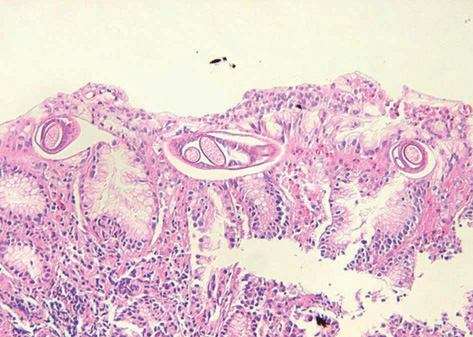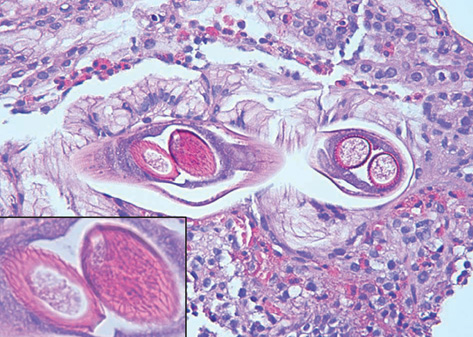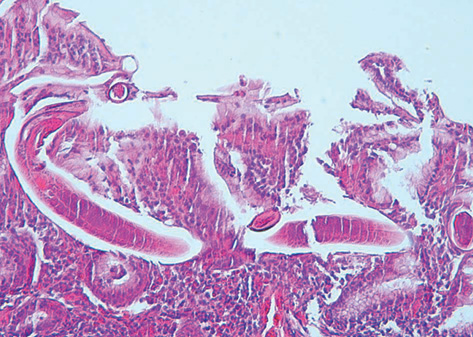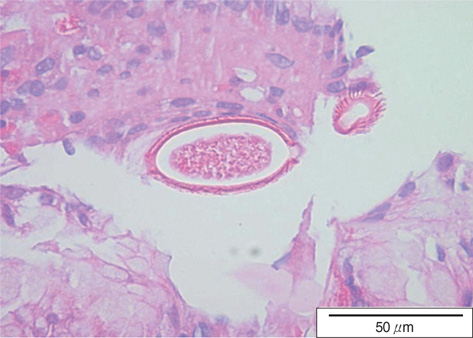J Korean Med Sci.
2009 Oct;24(5):963-966. 10.3346/jkms.2009.24.5.963.
A Case of Gastritis Associated with Gastric Capillariasis
- Affiliations
-
- 1Department of Parasitology, Seonam University College of Medicine, Namwon, Korea. jinkim16@hanmail.net
- 2Departments of Internal Medicine and Family Medicine, Eun Hospital, Gwangju, Korea.
- 3Foryou Pathology Laboratory, Gwangju, Korea.
- 4Department of Legal Medicine, Chonnam National University Medical School, Gwangju, Korea.
- KMID: 1782024
- DOI: http://doi.org/10.3346/jkms.2009.24.5.963
Abstract
- This report is about the case of gastritis associated with capillariasis. The patient was a 52-yr-old Korean woman who occasionally ate raw fish and chicken. She complained of mild abdominal pain and nausea, but not diarrhea. An endoscopic examination revealed an exudative flat erosive change on the gastric mucosa of the antrum. She was microscopically diagnosed as chronic gastritis with numerous eosinophil infiltrations. The sectioned worms and eggs in mucosa were morphologically regarded as belonging to the genus Capillaria. This is the first case of gastric capillariasis reported in the Republic of Korea.
Keyword
MeSH Terms
Figure
Reference
-
1. Cross JH. Intestinal capillariasis. Clin Microbiol Rev. 1992. 5:120–129.
Article2. Beaver PC, Jung RC, Cupp EW. Clinical Parasitology. 1984. Philadelphia: Lea & Febiger;231–252.3. Hong ST, Cross JH. Arizono N, Chai JY, Nawa Y, Takahashi Y, editors. Capillaria philippinensis infection in Asia. Asian Parasitology. 2005. vol. 1 Food-borne helminthiasis in Asia. Chiba: Federation of Asian Parasitologists;225–229.4. Lee SH, Hong ST, Chai JY, Kim WH, Kim YT, Song IS, Kim SW, Choi BI, Cross JH. A case of intestinal capillariasis in the Republic of Korea. Am J Trop Med Hyg. 1993. 48:542–546.
Article5. Hong ST, Kim YT, Choe G, Min YI, Cho SH, Kim JK, Kook J, Chai JY, Lee SH. Two cases of intestinal capillariasis in Korea. Korean J Parasitol. 1994. 32:43–48.
Article6. Okulewicz A, Zalesny G. Biodiversity of Capillariinae. Wiad Parazytol. 2005. 51:9–14.7. Fresh JW, Cross JH, Reyes V, Whalen GE, Uylangco CV, Dizon JJ. Necropsy findings in intestinal capillariasis. Am J Trop Med Hyg. 1972. 21:169–173.8. Chitwood MB, Valesquez C, Salazar NG. Capillaria philippinensis sp. n. (Nematoda: Trichinellida), from the intestine of man in the Philippines. J Parasitol. 1968. 54:368–371.
Article9. Hong ST, Lim HS, Kim DH, Kim SJ. A case of gastroenteritis associated with gastric trichuriasis. J Korean Med Sci. 2003. 18:429–432.
Article10. Cross JH, Basaca-Sevilla V. Experimental transmission of Capillaria philippinensis to birds. Trans R Soc Trop Med Hyg. 1983. 77:511–514.
Article
- Full Text Links
- Actions
-
Cited
- CITED
-
- Close
- Share
- Similar articles
-
- Gastritis Cystica Profunda: A case report
- A Case of Eosinophilic Gastritis with Delayed Gastric Emptying
- A Case of Gastritis Cystica Polyposa Presenting as Multiple Polypoid Lesions
- A Case of Gastric Wall Abscess Associated with Gastritis Cystica Profunda
- Assessment of Gastritis Using Operative Link for Gastritis Assessment System






